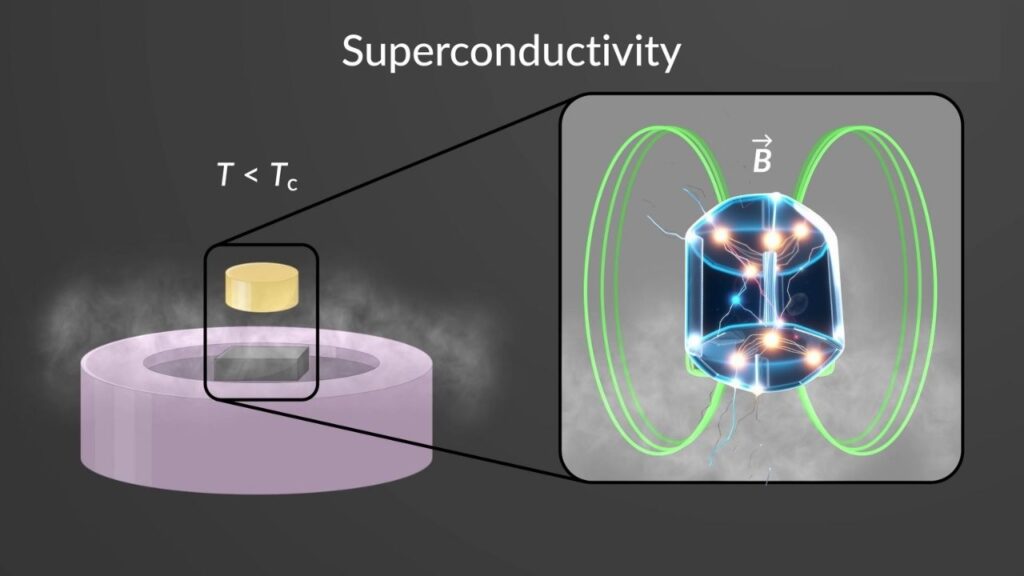Electric Field Trick Revealed That Can Instantly Switch Off Superconductivity: In a remarkable breakthrough, physicists have figured out how an electric field can instantly switch off superconductivity—a property where materials conduct electricity with zero resistance. This discovery, made possible by new theoretical modeling, is not just a scientific curiosity but a giant leap toward futuristic devices like superconducting transistors and ultra-efficient quantum computers.

The ability to switch superconductivity on and off with an electric field has long been the “holy grail” of materials science. For decades, researchers knew that magnetic fields could suppress superconductivity. But now, we have a clear understanding of how electric fields can do the same—offering a far more scalable and energy-efficient control mechanism for next-gen tech.
Electric Field Trick Revealed That Can Instantly Switch Off Superconductivity
| Feature | Details |
|---|---|
| Discovery | Electric field can break Cooper pairs and switch off superconductivity |
| Field Strength | Around 100 million volts per meter (10⁸ V/m) needed |
| Materials | Ultrathin films like niobium nitride (NbN) |
| Theoretical Basis | Based on Eliashberg theory of superconductivity |
| Device Impact | Could lead to electric field-controlled superconducting transistors |
| Main Researcher | Prof. Alessio Zaccone (University of Pisa and Turin) |
| Published In | Physical Review B |
| Official Website | aps.org |
The ability to switch off superconductivity using an electric field isn’t just a lab curiosity—it’s a pivotal advancement that could reshape everything from quantum computing to green energy. By disrupting Cooper pairs with precision-tuned electric fields, researchers have laid the foundation for a new class of field-controlled superconducting devices.
As the science evolves and this technique is refined for wider materials and real-world use, we may see it form the backbone of energy-efficient electronics, superconducting logic, and powerful quantum processors.
What Is Superconductivity and Why Does It Matter?

Let’s start with the basics. Superconductivity is a state in which certain materials can carry electrical current with zero resistance. That means no energy is lost as heat—unlike regular wires, which waste energy during transmission. This makes superconductors ideal for magnetic levitation trains, MRI machines, and potentially quantum computers.
But there’s a catch: superconductors typically need extremely low temperatures, close to absolute zero (-273°C), to work. And until recently, controlling when a material enters or exits this superconducting state required magnetic fields—not very practical for tiny electronics.
The Breakthrough: How an Electric Field Can Switch Off Superconductivity
The Trick with Electric Fields
Here’s the exciting part: in very thin superconducting films—just 10 to 30 nanometers thick (that’s about 1000 times thinner than a human hair)—electric fields can actually penetrate the material. This is because there aren’t enough free electrons in these films to completely block the field.
Once inside, the electric field does something clever. It causes quantum tunneling, a phenomenon where one of the two paired electrons (called Cooper pairs) tunnels away, breaking the pair. When this happens, superconductivity vanishes.
“It’s like flipping a switch,” said Prof. Zaccone. “You apply the field, and suddenly the material loses its superpower.”
The Physics Behind It

Using the advanced Eliashberg theory, researchers calculated that an electric field of ~10⁸ V/m is enough to disrupt Cooper pairing. These calculations matched up with real-world experiments using materials like NbN (niobium nitride) and ultrathin aluminum.
You can think of the Cooper pair like a dance between two electrons. They glide smoothly through the material without bumping into anything (which causes resistance). But once the electric field is strong enough, it separates the dancers, and the magic is gone.
Practical Applications: Superconducting Devices of the Future
This discovery opens the door to a host of next-generation technologies:
Superconducting Transistors

Traditional transistors use electric fields to control the flow of current. If we can now control superconductivity with electric fields too, we might soon build superconducting transistors—which could be:
- Faster
- Smaller
- More energy-efficient
…than anything silicon can achieve today.
Quantum Computing

Quantum computers often rely on superconducting qubits. Right now, magnetic fields are used to manipulate these delicate quantum states. Electric fields would offer more precise, faster, and localized control, reducing noise and increasing qubit stability.
Green Energy
Superconductors are already used in energy-efficient power cables. The ability to toggle superconductivity could allow grids to respond dynamically to demand—saving even more energy.
Step-by-Step: How the Electric Field Switch Works
Let’s break it down simply:
- Start with a superconducting ultrathin film like NbN.
- Cool it below its superconducting transition temperature (e.g., 15 K).
- Apply a static electric field using a gate electrode.
- Field penetrates the thin film due to limited electron screening.
- Electric field pulls one electron away via quantum tunneling.
- Cooper pair breaks, and the material loses superconductivity.
That’s it! You’ve just toggled superconductivity with a field.
Real-World Experiments and Data
- Experiments at institutions like MIT, Stanford, and the University of Pisa have demonstrated this effect.
- A 2018 experiment used Aluminum films (~5 nm) and observed suppression of superconductivity at ~100 MV/m.
- Materials used: NbN, Aluminum, and other superconducting nitrides.
Note: These experiments require cryogenic temperatures, but the principles could apply to higher-temperature superconductors in the future.
Why This Matters for Professionals
For engineers, materials scientists, and quantum physicists, this is more than a scientific milestone. It means:
- Simpler device architecture: No need for bulky magnets to control superconductivity.
- Higher integration: Electric field control allows finer scaling in chip design.
- Improved modeling tools: Eliashberg theory adaptations help in designing new superconducting materials.
Professionals developing logic gates, quantum processors, and low-loss transmission systems should take this breakthrough seriously—it could be the missing piece.
Carbon Emissions From Tech Sector Rise With AI Expansion, Report Warns
AI Predicts Stronger Metal‑Doped Materials With Improved Mechanical Properties
Precisely Placed Platinum Atoms Boost Catalyst Efficiency and Speed
FAQs About Electric Field Trick Revealed That Can Instantly Switch Off Superconductivity
Can this effect be used at room temperature?
Not yet. Current superconductors that show this behavior still require cryogenic cooling. However, this discovery could guide future research toward room-temperature superconductors with field control.
What materials are most promising?
Materials like niobium nitride (NbN) and aluminum in thin-film form are currently the best candidates. Research is expanding into cuprates and iron-based superconductors.
Is this safe for commercial use?
The electric fields involved are extremely high and confined to small, well-controlled lab environments. For practical devices, miniaturized field generators would be developed.
How does this compare to magnetic field suppression?
Electric fields offer more precision, speed, and compact design options compared to magnetic fields, making them more suitable for nanoelectronics.






